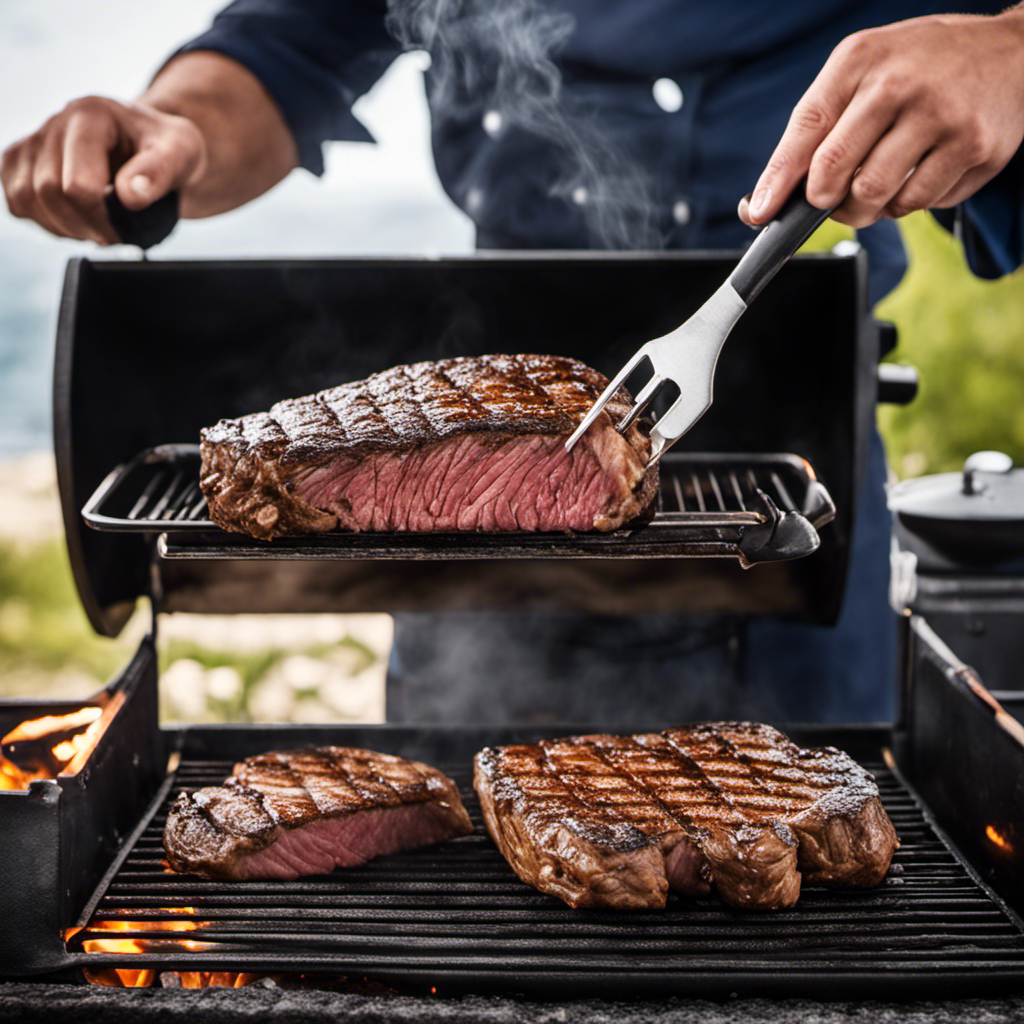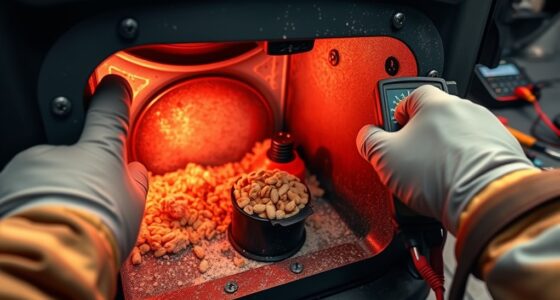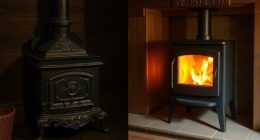Grilling has always been a passion of mine, but it was only recently that I entered the amazing realm of wood pellet grills. Trust me, it has entirely changed the game.
These versatile and easy-to-use grills take your barbecuing skills to a whole new level. From choosing the right wood pellets to mastering temperature controls, I’ll guide you through everything you need to know about using a wood pellet grill.
Get ready to elevate your grilling game and impress your friends and family with mouthwatering flavors that only a wood pellet grill can deliver.
Key Takeaways
- Choose wood pellets based on the desired flavor profile for different types of meat.
- Properly preheat the grill to ensure even cooking and enhanced flavor development.
- Understand temperature controls and troubleshoot any fluctuations for optimal cooking results.
- Clean and maintain the grill regularly using essential cleaning tools to ensure optimal performance and food safety.
Choosing the Right Wood Pellets
When choosing the right wood pellets for your grill, it’s important to consider the type of flavor you want to achieve. Wood pellet flavors can greatly enhance the taste of your grilled food, so selecting the best wood pellet brands is crucial. There are numerous options available, each offering a unique flavor profile.
For example, hickory pellets provide a strong and smoky taste that pairs well with beef or pork. If you prefer a milder flavor, applewood pellets are an excellent choice for poultry or fish. Mesquite pellets offer a bold and intense flavor that complements red meat perfectly.
By understanding the different wood pellet flavors and choosing reputable brands, you can ensure delicious results when grilling.
Now let’s move on to setting up the wood pellet grill for optimal performance.
Setting up the Wood Pellet Grill
To get started with your new wood pellet grill, all you need to do is set it up properly.
First, make sure you have all the necessary wood pellet grill accessories, such as a meat thermometer and grill cover, at hand.
Then, carefully read through the instruction manual provided by the manufacturer. This will give you a step-by-step guide on how to assemble and troubleshoot common issues that may arise during setup. Pay close attention to details like proper placement of components and ensuring a stable base for your grill.
Once you have completed the setup process, you are ready to move on to preheating the grill and getting it ready for cooking. Simply follow the next section for instructions on how to preheat your wood pellet grill.
Transition: Now that we have set up our wood pellet grill correctly, let’s move on to preheating it for optimal cooking performance.
Preheating the Grill
When it comes to preheating the grill, there are a few key points to keep in mind.
First and foremost, it’s important to know the optimal preheating temperature for your specific wood pellet grill. This will ensure that your grill reaches the desired heat level for cooking.
Additionally, following preheating time recommendations is crucial to achieving the best results. Different grills may have different recommended preheating times, so be sure to consult your grill’s manual or manufacturer’s guidelines.
Optimal Preheating Temperature
Make sure you’re preheating your wood pellet grill to the optimal temperature. Achieving the right temperature is crucial for successful grilling, as it ensures even and thorough cooking of your food. The optimal cooking temperature can vary depending on what you’re grilling, but generally falls between 225°F and 250°F (107°C and 121°C). This range allows for slow and low cooking, resulting in tender and flavorful dishes.
To achieve this temperature, there are a few temperature control techniques you can employ. Firstly, adjust the airflow by opening or closing the vents to regulate heat circulation. Secondly, monitor the grill’s thermometer regularly to maintain a steady temperature throughout the cooking process. These techniques will help you achieve delicious results every time.
Moving on to preheating time recommendations…
Preheating Time Recommendations
Achieving the optimal preheating temperature is crucial for successful grilling on a wood pellet grill. To ensure your grill is ready for cooking, it’s important to follow proper preheating techniques. The recommended preheating time will vary depending on the specific model and brand of your wood pellet grill. Generally, it takes about 10-15 minutes for the grill to reach the desired temperature. However, if you’re experiencing issues with preheating, there are troubleshooting steps you can take. First, make sure that the pellets are properly ignited and producing smoke. Check for any blockages in the airflow or fuel delivery system that may hinder heating efficiency. Additionally, ensure that the grill’s temperature control settings are correctly adjusted. By addressing these common preheating issues, you can optimize your grilling experience.
Transitioning into the subsequent section about the benefits of preheating:
Properly preheating your wood pellet grill not only ensures food safety but also enhances flavor and cooking performance.
Benefits of Preheating
Preheating your wood pellet grill is a crucial step before cooking, as it offers numerous benefits and highlights the importance of this process. By preheating, you ensure that your grill reaches the desired temperature, allowing for even heat distribution and consistent cooking results.
Here are some key benefits of preheating:
-
Improved Cooking Performance: Preheating helps to eliminate any residual moisture or contaminants from previous use, creating a clean cooking surface.
-
Enhanced Flavor Development: When the grill is properly preheated, it allows for better smoke production and absorption into the food, resulting in delicious smoky flavors.
-
Reduced Cooking Time: With a preheated grill, food cooks faster and more efficiently since it’s exposed to high temperatures from the start.
Transitioning into understanding temperature controls without explicitly stating ‘step,’ let’s now explore how to effectively manage and adjust the temperature on your wood pellet grill.
Understanding Temperature Controls
To properly use your wood pellet grill, you’ll need to familiarize yourself with the temperature controls. Controlling the temperature is crucial for achieving perfectly cooked and flavorful meals. Here are some temperature control tips to help you get started:
- Preheat your grill: It’s essential to preheat your grill before cooking to ensure consistent heat distribution.
- Use the temperature dial: Adjust the temperature dial according to your desired cooking temperatures.
- Monitor the thermometer: Keep an eye on the built-in thermometer to track the internal temperature of your grill.
Troubleshooting Temperature Fluctuations:
| Issue | Solution |
|---|---|
| High Fluctuations | Check for air leaks and adjust vents accordingly |
| Low Fluctuations | Clean out ash and debris from burn pot |
Adding Wood Pellets to the Grill
Now that you understand how to control the temperature on your wood pellet grill, let’s talk about adding wood pellets to enhance the flavor of your food. Wood pellets come in a variety of flavors, each offering its own unique taste profile.
Here are the benefits of using wood pellets on your grill:
-
Enhanced Flavor: Wood pellet flavors such as hickory, mesquite, apple, and cherry infuse a delicious smoky taste into your food.
-
Versatility: With different types of wood pellets available, you can experiment with various flavors to match your dishes perfectly.
-
Consistent Burn: Wood pellets provide a consistent and even burn throughout the grilling process, ensuring that your food is cooked evenly.
-
Natural Ingredients: Wood pellets are made from natural materials, making them a healthier alternative to charcoal or gas.
By adding wood pellets to your grill, you can elevate the taste of your dishes and create mouthwatering flavors.
Now let’s explore the various cooking techniques you can utilize on a wood pellet grill.
Cooking Techniques on a Wood Pellet Grill
Try experimenting with different cooking techniques on your wood pellet grill to achieve delicious and unique flavors in your dishes.
Cooking on a wood pellet grill offers a wide range of possibilities for flavor infusion. One popular technique is smoking, which imparts a rich smoky flavor to meats, fish, and vegetables. Simply set the temperature low, add your favorite wood pellets, and let the grill work its magic.
Another technique is grilling over direct heat, perfect for achieving those beautiful sear marks on steaks or burgers.
For a more gentle cooking method, try indirect grilling by placing your food away from the heat source. This allows for even cooking and prevents flare-ups.
Lastly, don’t forget about roasting! Use higher temperatures to cook larger cuts of meat or whole poultry to perfection.
Now that you know some cooking techniques for your wood pellet grill, let’s move on to cleaning and maintenance without compromising taste.
Cleaning and Maintenance of the Grill
When it comes to cleaning and maintaining a wood pellet grill, there are a few essential tools that I always rely on.
Firstly, a sturdy wire brush is crucial for removing any stubborn residue from the grill grates.
Additionally, a good quality grill cleaner is essential for tackling grease buildup and ensuring optimal performance of the grill.
To prevent grease buildup in the first place, regularly scraping off excess grease after each use and using drip pans to catch drippings are effective strategies.
Essential Cleaning Tools
To keep your wood pellet grill clean, you’ll need a few essential cleaning tools. Here are the three must-have items that will make your cleaning process easier and more effective:
-
Grill brush: A high-quality grill brush with stiff bristles is essential for removing charred residue and food particles from the grates. It helps to maintain the cleanliness of your grill surface.
-
Cleaning solution: Use a specialized grill cleaner or a mixture of warm water and mild dish soap to effectively clean the interior and exterior of your wood pellet grill. This solution will help break down grease and grime, leaving your grill sparkling clean.
-
Microfiber cloth: A soft microfiber cloth is perfect for wiping down surfaces after cleaning. It absorbs moisture quickly, preventing any streaks or residue from being left behind.
By regularly using these cleaning supplies and following a maintenance schedule, you can ensure that your wood pellet grill remains in top condition for years to come.
Now let’s move on to preventing grease buildup to keep our grills functioning optimally without any hitches.
Preventing Grease Buildup
Maintaining a regular cleaning routine is crucial for preventing grease buildup and ensuring optimal performance of your grilling equipment. Grease buildup not only affects the taste of your food but can also pose a serious fire hazard.
To prevent grease fires, it’s important to practice proper grease management tips. Firstly, always scrape off excess grease and residue from the grill grates after each use. This prevents them from accumulating over time.
Secondly, regularly clean out the drip tray or grease bucket to avoid overflow and potential flare-ups.
Lastly, inspect and clean the internal components of your grill, such as the burn pot and heat diffuser, as they can also accumulate greasy deposits.
Frequently Asked Questions
Can I Use Regular Charcoal or Gas Instead of Wood Pellets in a Wood Pellet Grill?
Yes, you can use regular charcoal or gas instead of wood pellets in a wood pellet grill. However, using wood pellets offers several advantages such as enhanced flavor and the ability to control temperature more precisely.
How Long Does It Take for a Wood Pellet Grill to Preheat?
Preheating a wood pellet grill typically takes around 10-15 minutes. It’s an important step to ensure consistent temperature control for cooking. Remember to clean the grates regularly for optimal performance and flavor.
Can I Adjust the Temperature on a Wood Pellet Grill While Cooking?
Yes, you can definitely adjust the temperature on a wood pellet grill while cooking. This feature allows for precise control over the heat, making it easier to experiment with different cooking techniques and achieve perfect results every time.
How Often Should I Add Wood Pellets to the Grill During a Long Cook?
During a long cook on a wood pellet grill, I add wood pellets every hour to maintain the consistent temperature and smoky flavor. It’s important to monitor the pellet hopper and ensure an ample supply of fuel.
What Is the Best Way to Clean the Grates of a Wood Pellet Grill After Use?
Cleaning the grates of a wood pellet grill is an important part of maintenance. After use, I recommend scrubbing them with a wire brush and warm soapy water to remove any residue or stuck-on food.
Conclusion
In conclusion, using a wood pellet grill is truly a game-changer in the world of grilling. With the right wood pellets, you can achieve incredible flavors and aromas that will tantalize your taste buds.
Setting up and preheating the grill properly is crucial for optimal results. Understanding temperature controls will give you precision in cooking, enhancing your culinary skills.
Adding wood pellets to the grill will infuse your food with smoky goodness. And lastly, maintaining and cleaning the grill ensures its longevity and continued performance.
So go ahead, embrace this delightful cooking technique and elevate your grilling experience to new heights!











